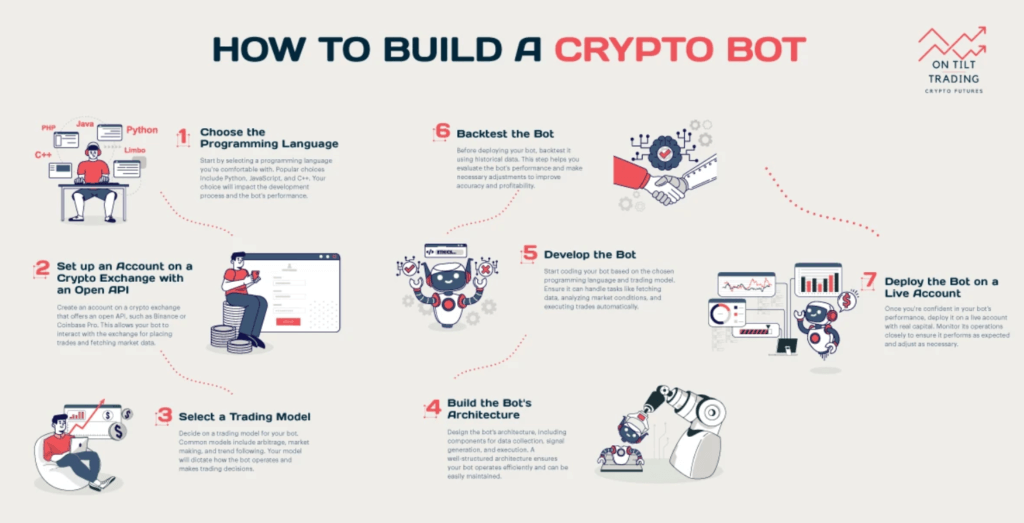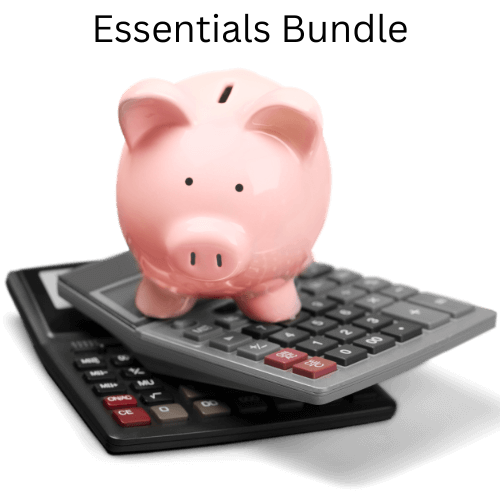Professional traders earn 50x and 100x of their investment utilizing trading bots. Although only 38% of cryptocurrency users trade with bots, these bots handle 86% of the total money traded. Shocking right? You should also use trading bots to win big. What are trading bots? How to start bot trading? We will explain everything so that you have a clear understanding.
What are Trading Bots?
Trading bots are automated software programs that execute trades. They use complex algorithms to analyze market data and make trades on your behalf. These bots can operate 24/7.

To maximize profits, you can apply custom strategies for buying low and selling high. Trading bots are popular among experienced traders and beginners because they can help manage trades without needing constant attention. This automation can lead to more consistent and potentially profitable trading.
Before you can start bot trading, you’ll need to choose a trading platform that supports bot integration. Your choice will depend on the market you want to trade in and the features you need. PrimeXBT is a reliable platform for participating in trading. Use the promo code PRIMEOTT and receive a +7% bonus on your deposit. You can start trading without the risk of losing money. Join Prime XBT
How to Start Bot Trading?
Selecting a Trading Bot
There are many trading bots available, each with its own features and capabilities. When selecting a bot, consider your level of experience, the markets you want to trade in, and the bot’s reputation.
Check these 3 popular trading bots:
- 3Commas: Offers a wide range of bots and integrates with multiple exchanges. It provides features like portfolio tracking, smart trading terminals, and social trading.
- HaasOnline: A powerful bot with advanced features for experienced traders. It supports backtesting, simulated trading, and a variety of technical indicators.
- Cryptohopper: User-friendly and great for beginners. It offers template strategies, a marketplace for purchasing strategies, and extensive educational resources.
Setting Up Your Trading Bot
Step 1: Create an Account
Sign up for an account on your chosen trading platform. Complete any required verification, such as identity verification, to ensure your account is fully functional and secure.
Step 2: API Key Generation
Now, generate API keys from your trading platform. These keys allow the bot to access your account and execute trades. Most platforms have a straightforward process for generating API keys.
Step 3: Connect the Bot to Your Exchange
Enter the API keys into your trading bot software. This step usually involves copying and pasting the keys into the bot’s settings or integration page. Ensure you enable the necessary permissions, such as trading access. Disable any permissions that are not required.
Developing Your Trading Strategy
A trading strategy is a set of rules that determine when and how the bot will trade. Developing a robust strategy is crucial for successful bot trading.
Common Strategies:
- Arbitrage: This strategy exploits price differences between markets. What does that mean? The bot buys an asset in one market where the price is low and sells it in another market where the price is higher.
- Trend Following: This strategy involves buying when prices are rising and selling when they are falling. It’s based on the idea that trends, once established, are likely to continue.
- Mean Reversion: This strategy assumes that prices will revert to their mean or average over time. The bot buys when prices are low and sells when they are high.
There are other strategies you can choose from. Some bots help you to implement custom strategies.
But, before deploying your strategy, backtest it using historical data to see how it would have performed. Most trading bots have built-in backtesting tools that allow you to simulate your strategy on past market data. It helps you identify potential weaknesses in your strategy and refine it before risking real money.
Configuring Your Trading Bot
Step 1: Set Trading Pairs
Choose the assets or trading pairs your bot will trade. For example, you might choose BTC/USD or ETH/BTC in crypto trading. To avoid slippage and ensure smooth trade execution, make sure the pairs you select have sufficient liquidity.
Step 2: You Have to Define Entry and Exit Conditions
Specify the conditions under which the bot will enter or exit trades. These conditions could be based on technical indicators like moving averages, RSI (Relative Strength Index), or MACD (Moving Average Convergence Divergence).
For example, you might set the bot to buy when the 50-day moving average exceeds the 200-day moving average and sell when the reverse occurs.
Step 3: Risk Management
Set parameters for managing risk. This includes setting stop-loss orders to limit losses and take-profit orders to lock in gains. You can also use trailing stops to adjust your stop-loss level as the trade moves in your favor.
Step 4: Position Sizing
You have to determine how much of your capital the bot will use for each trade. Avoid risking too much on a single trade to minimize potential losses. A common rule is to risk no more than 1-2% of your total capital on any single trade.
Monitoring and Adjusting Your Bot
Once your bot is live, monitor its performance regularly. You have to check for any issues and ensure it is executing trades as expected.
Regular monitoring helps you identify and address any problems early, ensuring your bot operates smoothly.
Besides, the bot’s performance should be analyzed over time. Look at metrics like profit and loss, win rate, and drawdown. Furthermore, compare these metrics to your backtesting results to see if the bot performs as expected.
Based on your performance review, make necessary adjustments to your strategy or bot settings.
Note: What worked in the past might not work in the future.
Security Considerations
Bot trading involves significant risk, especially if proper security measures are not in place. Here are some tips to keep your trading secure:
- Protect your accounts with strong, unique passwords. You should consider using a password manager to generate and store your passwords securely.
- Add an extra layer of security to your trading accounts. 2FA requires a second form of verification, such as a code sent to your phone, making it harder for unauthorized users to access your account.
- Do not share your API keys with anyone, and restrict their permissions to only what is necessary. Consider rotating your API keys periodically for added security.
- Keep your trading bot and related software updated to protect against vulnerabilities. Updates often include security patches and performance improvements.
Common Challenges and How to Overcome Them
Market Volatility
Bots can struggle in highly volatile markets. Ensure your strategy accounts for sudden market movements and has safeguards like stop-loss orders. Consider using volatility filters to avoid trading during extremely volatile periods.
Technical Issues
Bots can encounter technical problems like connection issues or software bugs. Regularly check your bot’s status and be prepared to intervene manually if needed. You have to use a reliable internet connection and consider running your bot on a dedicated server to minimize downtime.
Over-Optimization
Backtesting can lead to over-optimization, where a strategy performs well on historical data but poorly in live markets. Test your strategy in a demo environment before going live. Focus on developing a robust strategy that performs well across different market conditions rather than one that is highly optimized for past data.
Legal and Regulatory Considerations You Have to Take into Account
You should understand the legal and regulatory environment of the markets you are trading in. Different countries have varying regulations regarding automated trading. Ensure your bot complies with these regulations to avoid legal issues.
Research the regulations in your country and the countries where your chosen exchanges are located. Compliance with these regulations is crucial to avoid fines or other legal consequences.
Continuous Learning and Improvement
Stay updated with the latest trends, strategies, and technologies. You can join trading communities, attend webinars, and read up on new developments to keep your skills sharp.
You should take advantage of the wealth of educational resources available online. Many trading bot providers offer tutorials, guides, and forums where you can learn from experienced traders. Join online trading communities and forums to connect with other traders. Sharing experiences and insights can help you improve your strategies and stay informed about market trends.
Read More: AI Trading Bot For Beginners
Final Words
Following the guide, you can start bot trading. It has the potential to change the trading game completely. Still, if you are confused about setting up a trading bot, we recommend that you make things easier with Vestinda. The trading bot can make things easier for you.
The best part is that you can set your own strategies without requiring code writing. This can be helpful for both professional and novice traders. You can sign up for free and get started. Visit the official website Vestinda to know more.



